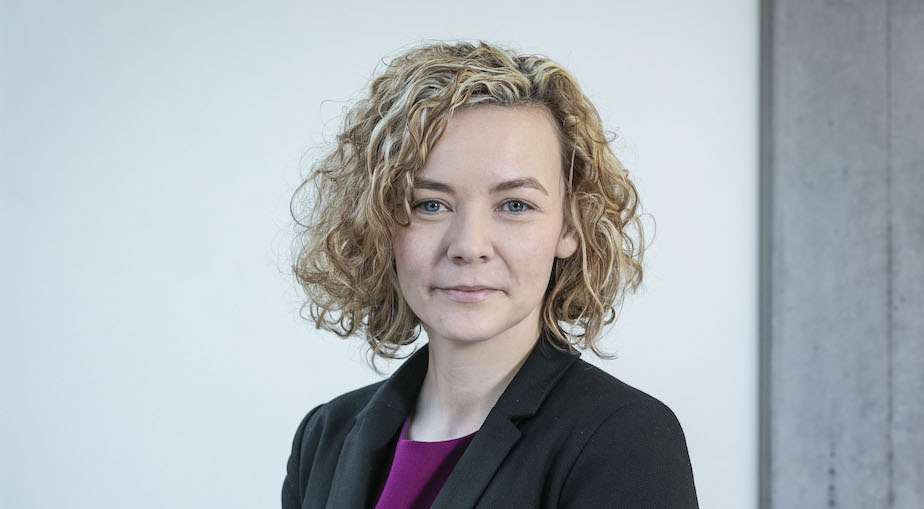How healthy is food on Irish supermarket shelves?
Sinead O’Mahony (pictured below) is a PhD student at the School of Agriculture and Food Science, Institute of Food and Health, University College Dublin. She also works for the Food Safety Authority of Ireland on their Food Reformulation Task Force.
Listen to the (opens in a new window)podcast.

How healthy is food on Irish supermarket shelves? PhD student Sinead O’Mahony used a validated measure from New Zealand, called the INFORMAS Food Availability in Supermarkets tool, which measures the proportion of shelf space allocated to healthy and unhealthy foods, in supermarkets, to assess the situation here. Preliminary analysis found almost 69% of shelf space in Dublin supermarkets contains unhealthy food.
“We applied it to a representative sample of supermarkets in Urban Ireland. The tool sets out to measure the proportion of shelf space in supermarkets given to foods that would be considered healthy and foods that would be considered unhealthy and we do that by using a proxy measure,” she explains.
The food categories included in the proxy measure for healthy foods are fresh and frozen fruit and vegetables and for unhealthy foods are sweets, chocolate, crisps, biscuits and sugary drinks.
“After measuring the shelf space allocated to those foods in the supermarket, we look at the proportion of how much of the shelf space was given to the healthy foods and how much was given to the unhealthy foods. in Ireland, preliminary analysis found that almost 69 centimetres of every 100 centimetres of shelf space, or 69% of shelf space, was given to unhealthy foods, using this proxy indicator.”
The purpose of undertaking this research was, O’Mahony says, to examine just one element of the food environment that influences our decision-making around food.
“We know that in order for people to employ healthy behaviours and healthy nutrition behaviours, the food environment that they live in has to support them to do that - but the food environment is very broad,” she says. “It's the retail environment like supermarkets, grocery stores, cafes, restaurants, but it's also where we work, where we live, where we go to school. One element of it is the food retail environment. And that was the area we set out to investigate.”
She says she and her PhD supervisors, Professor Gerardine Doyle, Professor Eileen Gibney and Nuala Collins, “weren’t overly surprised” by the results.
“Our findings are similar to what was found in other contexts. There were similar proportions of shelf space given to unhealthy foods in Australia and in New Zealand, where this research has also been conducted.”
“Our findings are similar to what was found in other contexts. There were similar proportions of shelf space given to unhealthy foods in Australia and in New Zealand, where this research has also been conducted.”
There was one area, however, in which Ireland differed.
“We were interested to find that the proportion of healthy and unhealthy foods available in our supermarkets didn't differ by area level deprivation. Other studies have found it does differ. So that was a positive finding from our research.”
Forming the backdrop to this new research is the troubling rate of overweight and obesity in Ireland.
“Approximately 60% of the adult population live with overweight and obesity. As part of the Childhood Obesity Surveillance Initiative, which is an initiative established by the World Health Organisation that Ireland participate in, we have seen that the prevalence of children aged nine years, living with overweight and obesity, has decreased in schools that aren't considered to be disadvantaged,” says O’Mahony. “So we are making some progress. But they have stagnated since 2008 among children who go to schools designated as DEIS, meaning they are considered disadvantaged. So overweight and obesity in Ireland really follows a social gradient.”
“Approximately 60% of the adult population live with overweight and obesity."
She believes a lot of focus is needed to tackle this widening gap between those who live in areas of higher and lower deprivation.
“In Ireland we have the Obesity Policy and Action Plan which was published by the Department of Health in 2016,” she says, which is a ten-step plan to address the structural drivers of overweight and obesity in our population.
“That action plan is coming into its final stages and ends in 2025. There have been midterm evaluations, and the final evaluation of that action plan will be really important to inform where we are making good progress, what we have done well and where we need to go in the future.”
Prior to joining UCD, O’Mahony worked as a nutritionist and nutrition advisor for charities Concern and Goal, respectively. During her years spent in Africa, the Middle East and Central America, her work involved tackling what is known as the double burden of malnutrition.
“It’s a very complex and difficult situation to address. When children are born small and they develop chronic malnutrition, they don't grow to their full height potential. They are shorter in stature and can gain weight quicker. That leads to an increased risk and rate of dietary related ill-health and non-communicable diseases like type two diabetes and cardiovascular disease later in life. This is the trend now that has been seen in some of the countries where I would have worked.”
Meanwhile back in Ireland, O’Mahony has a vision for progress in food healthfulness over the course of her lifetime. This includes a wish for food not to become “demonised” but to be enjoyed in an environment with healthy options as standard.
“Who doesn't love to meet friends and family and enjoy lovely meal? I would like to see us all continuing to do that but within a food environment that is more health enabling.”
Listen to the (opens in a new window)podcast. More Rising Stars. You can learn more about the work of the Food Reformulation Task Force on the FSAI website under the business advice section or by following this (opens in a new window)link.